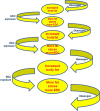Endocrine Disruptors and Obesity
- PMID: 28205155
- PMCID: PMC5359373
- DOI: 10.1007/s13679-017-0240-4
Endocrine Disruptors and Obesity
Abstract
Purpose of review: The purpose of this review was to summarise current evidence that some environmental chemicals may be able to interfere in the endocrine regulation of energy metabolism and adipose tissue structure.
Recent findings: Recent findings demonstrate that such endocrine-disrupting chemicals, termed "obesogens", can promote adipogenesis and cause weight gain. This includes compounds to which the human population is exposed in daily life through their use in pesticides/herbicides, industrial and household products, plastics, detergents, flame retardants and as ingredients in personal care products. Animal models and epidemiological studies have shown that an especially sensitive time for exposure is in utero or the neonatal period. In summarising the actions of obesogens, it is noteworthy that as their structures are mainly lipophilic, their ability to increase fat deposition has the added consequence of increasing the capacity for their own retention. This has the potential for a vicious spiral not only of increasing obesity but also increasing the retention of other lipophilic pollutant chemicals with an even broader range of adverse actions. This might offer an explanation as to why obesity is an underlying risk factor for so many diseases including cancer.
Keywords: Adipogenesis; Bisphenol A; Diethylstilbestrol; Endocrine disruptor; Endocrine-disrupting chemicals; Obesity; Obesogen; Paraben; Peroxisome proliferator-activated receptor; Persistent organic pollutants; Tributyltin.
Conflict of interest statement
Conflict of Interest
Philippa D. Darbre declares that she has no conflict of interest.
Human and Animal Rights and Informed Consent
This article does not contain any studies with human or animal subjects performed by any of the authors.
Figures




References
-
- • Darbre PD. Endocrine disruption and human health. New York: Academic; 2015. Overview of EDCs and human health which sets the bigger picture.
-
- • Heindel JJ, Schug TT. The obesogen hypothesis: current status and implications for human health. Curr Environ Health Rpt. 2014;1:333–40. Recent review of obesogens.
Publication types
MeSH terms
Substances
LinkOut - more resources
Full Text Sources
Other Literature Sources
Medical
Research Materials

